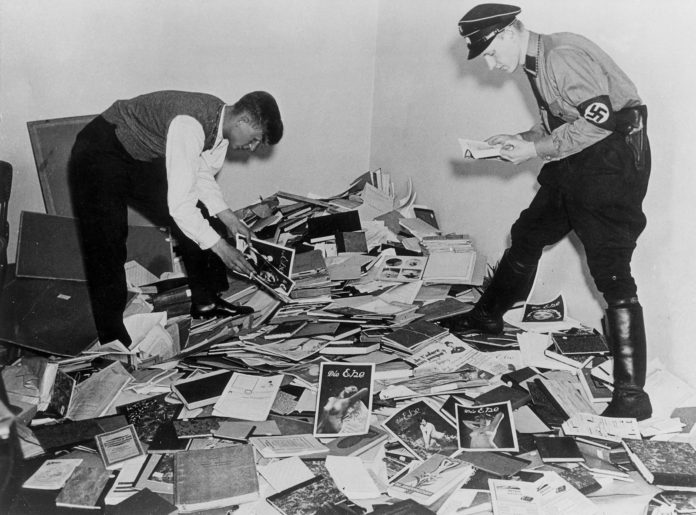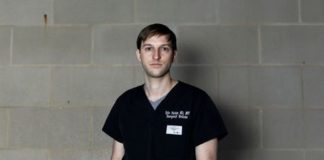
With the help of the Jewish community in Berlin, Dose and his friends launched a lecture series to mark 50 years since the destruction of the Institute for Sexual Science. Then they grew curious about the library’s holdings. “Everyone told us there was nothing left,” says Dose. “The institute was raided, then bombed, and the people are dead. Everything was lost. But, on the other hand, no one had searched for it.”
Reconstructing the past
They began to gather leads: They knew Hirschfeld had been travelling with a large collection on his world tour and ended up in France. They knew that someone had negotiated with the Nazis on his behalf to purchase 20 boxes of materials from the library before it was burned. He’d hoped to reopen his institute in Paris, but the material ended up in storage, likely in Nice or Paris. When he died, his personal items were left to two heirs—among them, Li Shiu Tong.
This year, a grant from the newly formed German Lost Art Foundation, which seeks to recover looted art and cultural heritage from World War II, will allow two researchers to construct a catalog of what the Institute for Sexual Science held, what’s been found, and what is still missing. Some of it is guesswork: they can be fairly certain that the leading sexology research of the day would have been owned by the institute, from medical texts to novels. But the Nazis’ seized holdings had first been distributed to other libraries, and then redistributed by British and American forces, scattering the books across Europe’s cultural centres.
The titles they’ve uncovered so far include the 1904 The women’s clothing and its natural development (found in Berlin), a 1920 copy of Three Essays on the Theory of Sexuality by Sigmund Freud (found in Prague), and Vita homosexualis, a 1902 collection by gay activist August Fleischmann (found in a Polish bookstore with a note saying it had been slated for destruction in 1933). This catalog will be distributed to museums and collections across the world, with the hopes that they use it to interrogate their own holdings for the trademark stamp of the Institute for Sexual Science.
On Dose’s wish list is an alluring collection of lost material that he’s found mentioned in diaries and catalogs. One collection was of particular interest to the Nazis: the institute’s patient files. These records detailed visits to the physicians who worked within the institute, from gynaecology exams to gender reassignment counselling to treatments for venereal diseases.
It’s possible that someone at the institute saw the writing on the wall as the Nazis rose to power and knew that thousands would be in danger if their names fell into the wrong hands. In one diary entry Dose found, a young worker described being asked to haul a cart of papers to a hiding spot. En route, the writer recalled, the cart tipped over in front of a Nazi officer who helped them regroup, unaware of the contraband it held. According to lore, those files were smuggled to Moscow by communist party members of the institute. No trace of them has been found.
Another item on Dose’s wish list: the “psycho-biological questionnaire.” Each person who visited the institute was asked to fill out this form, detailing their sexual preferences, lifestyle, and personality. Only one filled-in copy has been found, in the Berlin State Library, but an estimated 40,000 were once held at the institute for research purposes.
Beyond gay liberation
As he pieced together these findings, Dose realised how much broader Hirschfeld’s focus was than gay liberation. “For us he was a hero of the gay movement—one of the few ancestors we knew about,” he says. But as lost holdings surfaced, it became clear that the institute’s work dipped into reproductive rights, sexual health, women’s rights, and, later, transgender rights. “And so,” he says, “the scope of our research broadened and the scope of our ideas of the institute broadened very much.”
The Magnus Hirschfeld Society had once hoped that the German government would help rebuild the Institute for Sexual Science, but the political will never materialised. For decades, politicians didn’t want to be associated with the topic, Dose says. Not until the 1990s did the LGBTQ movement regain the power it once held under Hirschfeld.
“There was a whole gay and lesbian infrastructure in Germany—bars, clubs, the institute and organisations—that was destroyed. People were sent to prison and concentration camps. We wanted some compensation from German authorities,” Dose says. When that wasn’t forthcoming, “we reconstructed it ourselves.”
Today, their small library attracts researchers, students, and others interested in LBGTQ history, but it’s a far cry from the buzzing international research hub Hirschfeld had built. A half dozen volunteers donate their time to keep it running and the society receives a small stipend from the Berlin government to help pay the rent. It’s open just four hours per week.
The society hopes to soon merge with Berlin’s lesbian and feminist library and archives to form an umbrella queer archive with broad research access and communal spaces. They’re looking for 10 million euros to reconstruct a building and hire a professional staff.
The hunt for Hirschfeld’s lost papers, for now, remains a passion project of volunteers. Two years ago, on vacation in the south of France, Dose carved out time to visit a few ethnographic collections, bringing with him photos of artefacts that likely went with Hirschfeld into exile. He popped into antiquarian bookstores in search of German-language books. He didn’t find anything, but on the same trip, he met up with Hirschfeld’s great niece, who grew up in Australia, and was visiting France for work. She asked Dose to take her to visit the tomb of her great uncle.
At the time Hirschfeld was buried, the cemetery in Nice overlooked the sea. Now, it is surrounded by buildings and an airport. Hirschfeld’s flat headstone, inlaid with his portrait, was covered in pebbles left by visitors in the Jewish mourning tradition.
They lingered at the grave, glad to see it was being tended to. Dose would return to Germany without new materials for the archive, but he knew more would turn up through the blend of sleuthing and luck that has slowly filled the Magnus Hirschfeld Society’s shelves over the past 40 years. “We’ve learned to be patient,” Dose says. “Wait for things, and they will come.”







